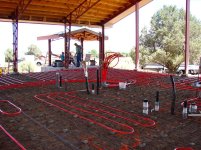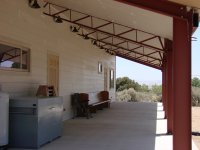Got2BTru
Silver Member
Seems like you should get yourself a good tractor and backhoe and dig the ditch yourself, put the conduit and pull boxes in to their specs and just have them pull the wire. I did this on my house, but it was only 220' from the pole. You'll save enough to pay for the tractor. I also bought an off-road forklift for the project and it too has paid for itself over and over. Then it will move on to another project somewhere, but my tractor stays!
By all means add hydronic radiant in your slab!!! But drive it with thermal solar. Very low cost of operation, also does domestic hot water and there is no heating system more comfortable. Last winter we used three 70 watt circulators, running during the day, to heat our 2,800 sq ft house through the winter. No energy source other than solar. But I also have a wood stove in case we want an evening fire or to take the chill off a surprise cool morning. Now, in the spring, summer and fall months, we have 650 gallons of domestic hot water on tap for occasional bathroom floor heat and unlimited showers. I can't imagine a cheaper or more comfortable heating system! Then, if you need to, you could add a simple air conditioning system that is entirely separate from your heating system. I added a simple duct system and wired the house for air conditioning, but I doubt I'll ever install it.
My priorities in the house design included a steel frame, but most of the structure is 2/6 and 2/8 walls with blown in insulation and blown in attic insulation. Not the absolute lowest heat loss, but totally practical and a structure that is incredibly strong.
I don't like propane, so I only put it in for cooking with the rangetop. I installed a cast iron boiler that runs on oil for backup if needed. Then I modified it to be more efficient than originally designed. We also have an electric water heater that remains permanently switched off unless the solar is shut down for more than about three days or in the event of severe winter conditions for an extended period. In the end, the cost of heating is insignificant
Be sure to include practicality in your design considerations. For instance, you might sacrifice a bit of theoretical R value for much simpler construction or lower cost or stronger structure. R value is only one of many considerations
I was initially told (on the phone) by National Grid that I can't dig the line for the electrical conduit. We'll see as I get closer and someone comes out to give me a firm price, etc.
What info can you point me to for your Steel Frame? I'm wondering if that's the way to go vs. timber frame since the style of house I'm looking at wouldn't benefit from the timber frames.



